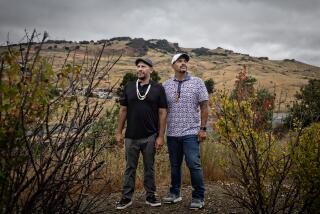Indian Burial Ground to Be Preserved in Mall’s Midst : Archeology: Compromise with descendants of Chumash and Salinans prevents bulldozing of Paso Robles site for a Wal-Mart.
- Share via
SAN FRANCISCO — When shoppers come to the new Wal-Mart in Paso Robles, they will be greeted by an unusual monument: a 1 1/2-acre knoll containing the remains of an ancient American Indian village and burial ground.
In an unusual compromise involving Indian activists, Wal-Mart and a Pasadena developer, the planned shopping mall will save one of a dwindling number of sacred Indian sites in California.
The agreement came after months of contentious negotiations between Indians and the mall’s developer, James Halferty, who had planned to bulldoze the burial site so the mall could be seen more easily from the highway.
Instead, the knoll above the Salinas River where Indians lived for thousands of years will be preserved intact, encircled by the mall parking lot, and marked by an oak tree and a simple historical plaque.
“This is an incredible win for the native people, and for all people who are interested in living in a world where there is respect for differences,” said Pilulaw Khus, a Chumash elder and healer who had joined in a court suit to block the shopping mall.
Throughout Southern California, she noted, other development projects have destroyed Indian burial grounds, which Indians consider to be as holy as a church or synagogue.
Wal-Mart, faced with threats of a nationwide boycott if the Paso Robles project went forward, had urged Halferty to reach a settlement with descendants of the Chumash and Salinan Indians who once populated the region.
“We believe the final results reflect a win-win-win situation,” Wal-Mart spokesman Don Shinkle said.
Halferty, who had predicted that he would defeat the suit in court, said he will spend $1 million to redesign the project to preserve the portion of the property considered significant by archeologists.
“With this compromise, the Native American community was satisfied and we’re able to proceed,” he said.
A second area also believed to have been a village and burial site will be capped with soil and paved over for a parking lot.
The Indians have agreed not to seek to halt the project if more bones are uncovered elsewhere on the property during construction. A skull fragment and finger bone were discovered on the knoll.
For Khus, the settlement is bittersweet.
“It will be really good to go there and know the grandmas and grandpas have not been torn out of their resting place,” she said. “The bitterness is that in order to get that protection for them, this shopping center will exist. There will be all this coming and going and confusion, and a parking lot covering part of the burial.”
At the same time, Khus said she believes that the shopping mall is temporary and that peace will someday return to the land where her ancestors are buried. “We understand this is a brief shadow that is passing,” she said.
Santa Barbara attorney James Nichols, who represented the Indians, encouraged other developers who find Indian remains at building sites to save themselves money and stress by negotiating early on with tribal leaders.
“Their land is gone and their culture is almost annihilated,” he said. “All they have left are these sacred burial grounds. Let’s try to preserve them.”
More to Read
Sign up for Essential California
The most important California stories and recommendations in your inbox every morning.
You may occasionally receive promotional content from the Los Angeles Times.










